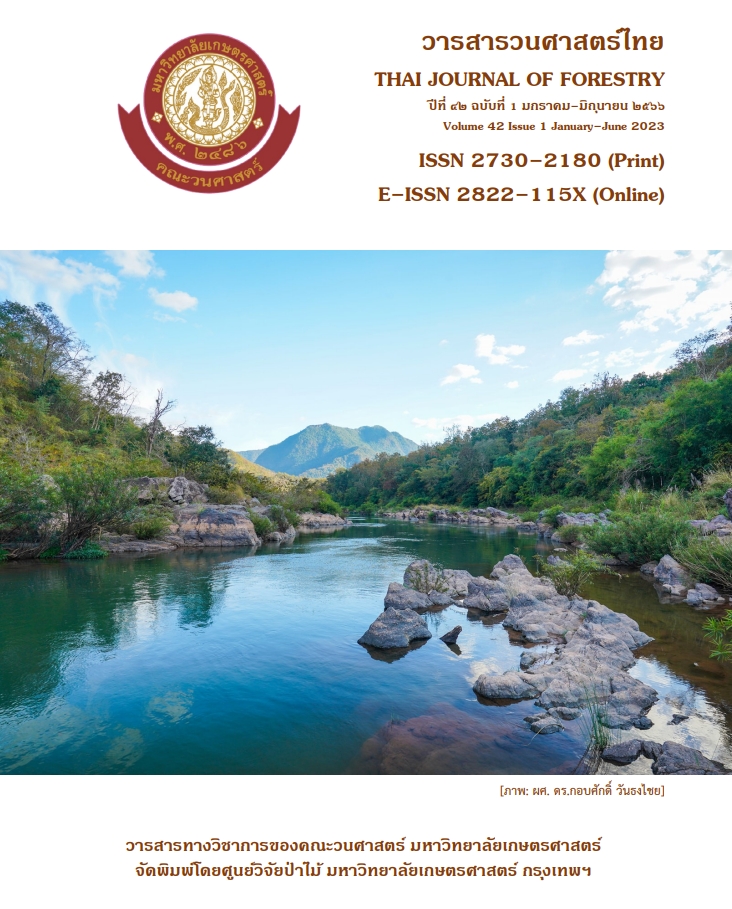การคาดคะเนการเปลี่ยนแปลงการใช้ที่ดินด้วยแบบจำลองโครงข่ายประสาทเทียม ของพื้นที่ลุ่มน้ำสาขาย่อยแม่สอย จังหวัดลำปาง
Main Article Content
บทคัดย่อ
การศึกษาครั้งนี้มีวัตถุประสงค์เพื่อประเมินและคาดการณ์การเปลี่ยนแปลงการใช้ที่ดินในพื้นที่ลุ่มน้ำสาขาย่อยแม่สอย จังหวัดลำปาง โดยใช้ข้อมูลภาพจากดาวเทียมปี พ.ศ. 2544, 2554 และ 2564 ในการติดตามการเปลี่ยนแปลงและคาดการณ์การใช้ที่ดินในพื้นที่ศึกษาในอนาคต ภาพดาวเทียมทั้ง 3 ปีต้องมีการปรับแก้เรขาคณิตเพื่อให้ภาพดาวเทียมเข้ากับระบบพิกัดภูมิศาสตร์ การประเมินความถูกต้องของการจำแนกประเมินด้วยค่าสถิติแคปปา และคาดการณ์การเปลี่ยนแปลงด้วยแบบจำลองโครงข่ายประสาทเทียมร่วมกับตัวแปรขับเคลื่อนการเปลี่ยนแปลงใช้ที่ดิน
ผลการศึกษาพบว่า มีการเปลี่ยนแปลงการใช้ที่ดินช่วงปี พ.ศ. 2544 – 2554 โดยพื้นที่เกษตรกรรมมีการเปลี่ยนแปลงลดลงมากที่สุด โดยเปลี่ยนเป็นพื้นที่ป่าไม้ประมาณ 30,011 ไร่ (4,801.76 เฮกตาร์) ในปี พ.ศ. 2554 – 2564 พื้นที่ป่าไม้ในเขตพื้นที่ชั้นคุณภาพลุ่มน้ำที่ 1 และ 2 ลดลงมากที่สุดโดยประมาณ 2,762 ไร่ (441.92 เฮกตาร์) จากการใช้แบบจำลองโครงข่ายประสาทเทียมเพื่อคาดการณ์การใช้ที่ดินในอีก 10 ปีข้างหน้า (ปี พ.ศ. 2574) ด้วยแพลตฟอร์ม Jupyter Notebook ให้ค่าความถูกต้องในการคาดการณ์สูงที่สุดคือ ร้อยละ 79.9 ผลลัพธ์จากการคาดการณ์ช่วงปี พ.ศ. 2564 – 2574 พื้นที่ป่าไม้มีแนวโน้มการเปลี่ยนแปลงลดลงอย่างต่อเนื่อง โดยพื้นที่ป่าไม้เปลี่ยนแปลงเป็นพื้นที่เกษตรกรรมประมาณ 13,268 ไร่ (2,122.88 เฮกตาร์) ควรมีมาตรการป้องกันและจัดสรรพื้นที่ที่เหมาะสมสำหรับการทำเกษตรกรรม เพื่อป้องกันไม่ให้พื้นที่เกษตรกรรมมีการขยายพื้นที่เข้าไปเขตพื้นที่ชั้นคุณภาพลุ่มน้ำที่ 1 และ 2 โดยเฉพาะในพื้นที่ตำบลแจ้ซ้อน และส่งเสริมการทำระบบวนเกษตรเพื่อใช้ประโยชน์จากทรัพยากรในพื้นที่ได้อย่างยั่งยืน
Downloads
Article Details

อนุญาตภายใต้เงื่อนไข Creative Commons Attribution-NonCommercial-NoDerivatives 4.0 International License.
ข้าพเจ้าและผู้เขียนร่วม (ถ้ามี) ขอรับรองว่า ต้นฉบับที่เสนอมานี้ยังไม่เคยได้รับการตีพิมพ์และไม่ได้อยู่ในระหว่างกระบวนการพิจารณาตีพิมพ์ลงในวารสารหรือสิ่งตีพิมพ์อื่นใด ข้าพเจ้าและผู้เขียนร่วม (ถ้ามี) ยอมรับหลักเกณฑ์และเงื่อนไขการพิจารณาต้นฉบับ ทั้งยินยอมให้กองบรรณาธิการมีสิทธิ์พิจารณาและตรวจแก้ต้นฉบับได้ตามที่เห็นสมควร พร้อมนี้ขอมอบลิขสิทธิ์ผลงานที่ได้รับการตีพิมพ์ให้แก่วารสารวนศาสตร์ คณะวนศาสตร์ มหาวิทยาลัยเกษตรศาสตร์ กรณีมีการฟ้องร้องเรื่องการละเมิดลิขสิทธิ์เกี่ยวกับภาพ กราฟ ข้อความส่วนใดส่วนหนึ่ง หรือ ข้อคิดเห็นที่ปรากฏในผลงาน ให้เป็นความรับผิดชอบของข้าพเจ้าและผู้เขียนร่วม (ถ้ามี) แต่เพียงฝ่ายเดียว และหากข้าพเจ้าและผู้เขียนร่วม (ถ้ามี) ประสงค์ถอนบทความในระหว่างกระบวนการพิจารณาของทางวารสาร ข้าพเจ้าและผู้เขียนร่วม (ถ้ามี) ยินดีรับผิดชอบค่าใช้จ่ายทั้งหมดที่เกิดขึ้นในกระบวนการพิจารณาบทความนั้น”
เอกสารอ้างอิง
Congalton, R.G., Green, K. 2019. Assessing the Accuracy of Remotely Sensed Data Principles and Practices, Third Edition. Boca Raton, FL, Taylor & Francis Group.
Department of Mineral Resources. 2011. landslide risk map at community level, Lampang Province. http://www.dmr.go.th/download/north/Lampang_final.pdf, 1 June 2011. (in Thai)
Forest Research and Development Office. 2013. Patterns of Forest Trees Planting in Agroforestry Systems. http://forprod.forest.go.th/forprod/silvic/for_plant/data/RFD/8.pdf, 1 May 2013. (in Thai)
Hermhuk, S., Marod, D. 2020. Detection and Prediction of Land-Use Changes at Doi Suthep-Pui Nation Park, Chiang Mai Province. Thai Journal of Forestry, 39(1): 97-109. (in Thai)
Hydro-Informatics Institute. 2015. 25 Watershed Information. https://tiwrm.hii.or.th/web/index.php/knowledge/128-hydro-and-weather/663-25basinreports.html, 29 July 2015. (in Thai)
Integrated Provincial Administrative Committee Lampang Province. 2022. Lampang Province 5-Year Development Plan (B.E. 2023-2027).http://www.lampang.go.th/strategy/index_pl.htm, 16 March 2022. (in Thai)
Kumar, P., Dugal, U. 2020. Tensorflow Based Image Classification using Advanced Convulational Neural Network. International Journal of Recent Technology and Engineering (IJRTE), 8(6): 994-998.
Kumpetch, P., Kongruang, C. 2016. The determination of agricultural land use in Northern Thailand case study: Areas planted paddy. Journal of Business, Economics and Communications, 11(1): 113-121. (in Thai)
Land Development Department. 2000. Summary of Land Use Types, Thailand 2000-2001. http://sql.ldd.go.th/ldddata/mapsoilB2.html, 27 November 2000. (in Thai)
Landis, J.R., Koch, G.G. 1977. The measurement of observer agreement for categorical data. Biometrics, 33(1): 159-174.
Maosew, K., Boonyanuphap, J. 2014. Analysis of land use change, root causes and potential impacts of the lower Num Samun sub-watershed of Nan province. Thai Journal of Forestry, 33(2): 131-148. (in Thai)
Pattaratuma, A. 1988. Land use and carrying capacity. In: The 26th Kasetsart University Annual Conference. Bangkok, Thailand, pp. 185-190. (in Thai)
Prakobphon, T. 2009. Artificial Neural Networks. HCU Journal, 12(24): 73-87. (in Thai)
Royal Forest Department. 2013. Summary of the Establishment of the Community Forest Project by Province. http://forestinfo.forest.go.th/fCom_area.aspx, 4 February 2013. (in Thai)
Royal Irrigation Department. 2009. Huai Mae Mae Reservoir Project. https://bit.ly/3sfV5PE, 21 May 2009. (in Thai)
Royal Irrigation Department. 2017. Work Manual. Irrigation Office 2, Lampang. (in Thai)


